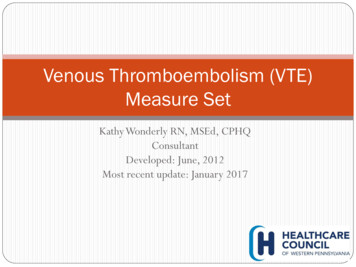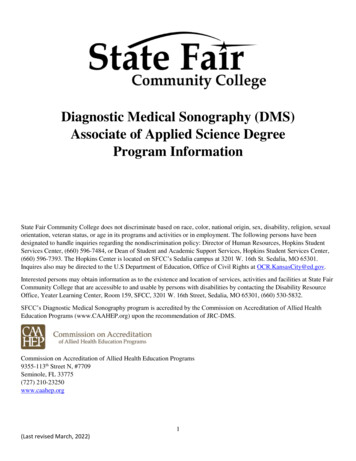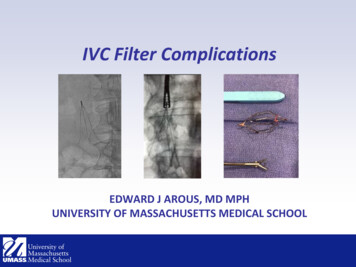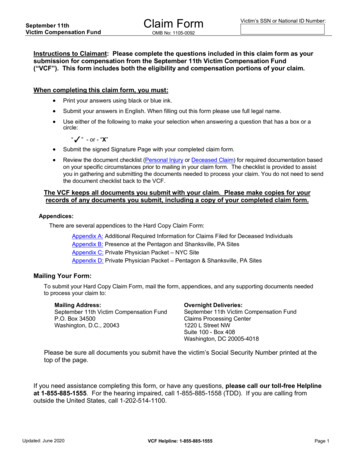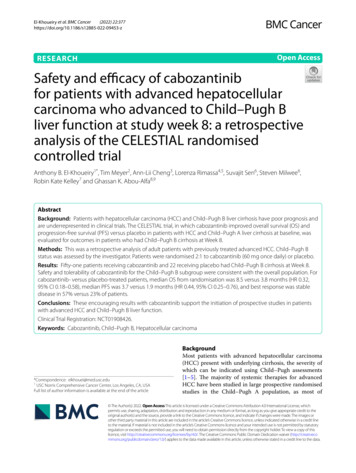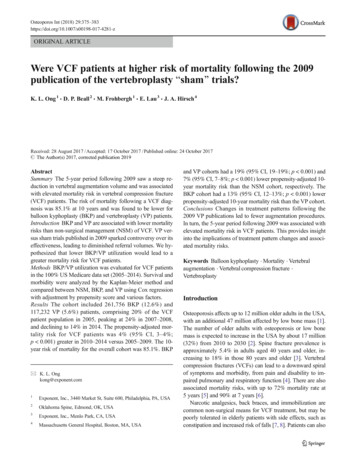
Transcription
Osteoporos Int (2018) 1-zORIGINAL ARTICLEWere VCF patients at higher risk of mortality following the 2009publication of the vertebroplasty Bsham trials?K. L. Ong 1 & D. P. Beall 2 & M. Frohbergh 1 & E. Lau 3 & J. A. Hirsch 4Received: 28 August 2017 / Accepted: 17 October 2017 / Published online: 24 October 2017# The Author(s) 2017, corrected publication 2019AbstractSummary The 5-year period following 2009 saw a steep reduction in vertebral augmentation volume and was associatedwith elevated mortality risk in vertebral compression fracture(VCF) patients. The risk of mortality following a VCF diagnosis was 85.1% at 10 years and was found to be lower forballoon kyphoplasty (BKP) and vertebroplasty (VP) patients.Introduction BKP and VP are associated with lower mortalityrisks than non-surgical management (NSM) of VCF. VP versus sham trials published in 2009 sparked controversy over itseffectiveness, leading to diminished referral volumes. We hypothesized that lower BKP/VP utilization would lead to agreater mortality risk for VCF patients.Methods BKP/VP utilization was evaluated for VCF patientsin the 100% US Medicare data set (2005–2014). Survival andmorbidity were analyzed by the Kaplan-Meier method andcompared between NSM, BKP, and VP using Cox regressionwith adjustment by propensity score and various factors.Results The cohort included 261,756 BKP (12.6%) and117,232 VP (5.6%) patients, comprising 20% of the VCFpatient population in 2005, peaking at 24% in 2007–2008,and declining to 14% in 2014. The propensity-adjusted mortality risk for VCF patients was 4% (95% CI, 3–4%;p 0.001) greater in 2010–2014 versus 2005–2009. The 10year risk of mortality for the overall cohort was 85.1%. BKP* K. L. Ongkong@exponent.com1Exponent, Inc., 3440 Market St, Suite 600, Philadelphia, PA, USA2Oklahoma Spine, Edmond, OK, USA3Exponent, Inc., Menlo Park, CA, USA4Massachusetts General Hospital, Boston, MA, USAand VP cohorts had a 19% (95% CI, 19–19%; p 0.001) and7% (95% CI, 7–8%; p 0.001) lower propensity-adjusted 10year mortality risk than the NSM cohort, respectively. TheBKP cohort had a 13% (95% CI, 12–13%; p 0.001) lowerpropensity-adjusted 10-year mortality risk than the VP cohort.Conclusions Changes in treatment patterns following the2009 VP publications led to fewer augmentation procedures.In turn, the 5-year period following 2009 was associated withelevated mortality risk in VCF patients. This provides insightinto the implications of treatment pattern changes and associated mortality risks.Keywords Balloon kyphoplasty . Mortality . Vertebralaugmentation . Vertebral compression fracture .VertebroplastyIntroductionOsteoporosis affects up to 12 million older adults in the USA,with an additional 47 million affected by low bone mass [1].The number of older adults with osteoporosis or low bonemass is expected to increase in the USA by about 17 million(32%) from 2010 to 2030 [2]. Spine fracture prevalence isapproximately 5.4% in adults aged 40 years and older, increasing to 18% in those 80 years and older [3]. Vertebralcompression fractures (VCFs) can lead to a downward spiralof symptoms and morbidity, from pain and disability to impaired pulmonary and respiratory function [4]. There are alsoassociated mortality risks, with up to 72% mortality rate at5 years [5] and 90% at 7 years [6].Narcotic analgesics, back braces, and immobilization arecommon non-surgical means for VCF treatment, but may bepoorly tolerated in elderly patients with side effects, such asconstipation and increased risk of falls [7, 8]. Patients can also
376become dependent on opioids, which can be dangerous ifmisused [9]. Alternatively, surgical interventions withvertebroplasty (VP) or balloon kyphoplasty (BKP) can provide improved pain relief, functional recovery, and healthrelated quality of life [8, 10–13]. Moreover, lower mortalityrisks have been reported for augmentation over non-surgicallymanaged (NSM) patients in the majority of claims-based studies [14–18]. A study of over one million elderly Medicarepatients with VCFs, including over 75,000 VP and 140,000BKP patients, described a 25 and 55% elevated mortality riskfor NSM than VP and BKP, respectively [16].In 2009, controversy sparked over the effectiveness of VPwith publications by Kallmes et al. and Buchbinder et al., withapproximately 200 patients in aggregate [19, 20]. Both identified no benefit in pain or functional improvements for VPover a Bsham procedure that included the periosteal injectionof local anesthetic [19, 20]. Yet periosteal local anestheticinfiltration can have a treatment effect, making it an activecontrol [21]; this is one of the important differences in trialdesign between the 2009 trials and a more recent VP trial [8,22]. A physician survey later showed that at least one of thesetwo Bsham control studies was directly linked to reducedenthusiasm for VP referrals, even though most still felt thatVP was an effective procedure in appropriate patients [23].Nonetheless, the period following those publications exhibited diminished volumes of vertebral augmentation [23–26].When taken in context of the trends in utilization of percutaneous interventional procedures for managing spinal pain [27,28], the decrease is almost certainly the direct or indirect resultof the two Bsham control studies.With questions raised about the effectiveness of VP and thecorresponding reductions in number of patients treated, thisstudy addressed the following research questions: (1) What isthe utilization of BKP/VP in the US elderly patient population? (2) Did the mortality risk for VCF patients differ between 2010 and 2014 and 2005–2009? (3) Are there differences in mortality and morbidity risks between BKP/VP andNSM patients?MethodsThe 100% inpatient/outpatient Medicare claims data (2005–2014) was used to identify newly diagnosed VCF patients(International Classification of Diseases, Ninth Revision,Clinical Modification (ICD-9-CM) codes 733.13, 805.0,805.2, 805.4, 805.6, and 805.8). The first VCF diagnosed inthe study period was used; patients were required to have atleast 12-month claims history prior to the VCF diagnosis toconfirm a VCF-free period. Patients with BKP/VP in the12 months before the index VCF were excluded. Those younger than 65 years old were also excluded due to potentialconfounding factors from their Medicare eligibility (certainOsteoporos Int (2018) 29:375–383disabilities, permanent kidney failure, amyotrophic lateralsclerosis, etc.). Patients enrolled in a Health MaintenanceOrganization plan (such as, Medicare Advantage plan), notenrolled in both Parts A and B of Medicare, not residing inthe 50 states, and without 12 months of claims history prior tothe VCF diagnosis were also excluded due to potential incompleteness in their claims history. The annual VCF incidencewas determined from the number of newly diagnosed VCFsand Medicare enrollees. The patients were stratified intoNSM, BKP, and VP cohorts. BKP/VP cohorts were thosewho underwent augmentation within the first year of theVCF diagnosis; those who underwent fusion surgery betweenthe VCF diagnosis and BKP/VP were excluded. The NSMcohort comprised of patients who did not undergo augmentation or fusion during the study period, and those who onlyunderwent augmentation or fusion 1 years after the indexVCF diagnosis. BKP was identified using ICD-9-CM code81.66 or Current Procedural Terminology (CPT) codes22289 and 22523–22525, while VP was identified usingICD-9-CM 81.65 or CPT codes 22520–22522. Spine fusionwas identified using ICD-9-CM codes 81.61, 84.51, 81.00–81.08, 81.30–81.39 or CPT codes 22532–22534, 22548,22554, 22556, 22558, 22585, 22590, 22595, 22600, 22610,22612, 22614, 22630, 22632, 22800, 22802, 22804, 22808,22810, 22812, 22840–22847, 22849, and 22851. This studywas based on publicly available data sets, did not use privatehealth identifiable information, and did not represent humansubject research, and therefore did not require oversight by ourinstitutional review boards.Mortality was the primary outcome, based on the date ofdeath from the Medicare denominator file, which containsenrollment and eligibility information. Mortality with pneumonia diagnosed as a principal diagnosis or any (principal orsecondary) diagnosis within 90 days prior to death was alsodetermined. Morbidity conditions examined in this study included myocardial infarction/cardiac complications (ICD-9CM codes 410, 997.1), deep venous thrombosis (451, 453),infection (diagnosis 996.67, 999.3, 998.5; procedure, ICD-9CM codes 77.69, 86.22, 86.28 or CPT codes 10180, 22010,22015), pulmonary embolism (415.11, 415.19), pneumonia(480–487), urinary tract infection (595.0, 595.2, 595.3,595.8, 595.89, 595.9, 599.0, 996.64), pulmonary/respiratorycomplications (490–496, 510–519), and readmissions. Alloutcomes were evaluated at up to 10 years follow-up, whilereadmissions were evaluated up to 1 year to limit the effectsfrom other unrelated interventions. The length of stay (LOS)and discharge status following the first VCF hospitalizationfor the NSM cohort and the index augmentation surgery forthe BKP and VP cohorts (inpatients) were compared.Mortality for VCF patients between the 2005–2009 and2010–2014 time periods was compared using multivariateCox regression, adjusting for propensity score, gender, age,race, census region, socioeconomic status, comorbidities, type
Osteoporos Int (2018) 29:375–383of fracture (traumatic or pathologic), fracture location (cervical, thoracic, lumbar, sacrum), initial VCF diagnosis site ofservice (inpatient, outpatient), physician specialty for initialVCF diagnosis, and treatment group (NSM, BKP, VP).Socioeconomic status was based on whether the patient’sMedicare premiums/deductibles were state subsidized(Medicare buy-in status), as well as the per capita incomefor the patient’s county of residence. Comorbidities were determined using the Charlson score [29] and the diagnosis of 12specific comorbid conditions in the 12 months prior to theVCF. The specific comorbid conditions comprised: (1) arterialdisease (ICD-9-CM codes 440–448), (2) chronic obstructivepulmonary disease (490–496), 3) cancer (140–176, 179–208,210–239, V10), (4) diabetes (250), (5) hip fracture (820), (6)hypertensive disease (401–405), (7) ischemic heart disease(410–414), (8) other heart disease (420–429), (9) pneumonia(480–487, V12.6), (10) pulmonary heart disease (415–417,V12.5), (11) stroke (430–438), and (12) wrist fracture(813.4, 813.5, 814.0, 814.1). Propensity score was derivedfor the probability of undergoing augmentation, using logisticregression conditional on gender, age, race, census region,socioeconomic status, comorbidities, type of fracture, diagnosis of osteoporosis, fracture location, initial VCF diagnosissite of service, physician specialty for initial VCF diagnosis,year, and two-way interactions for all the above covariates(except per capita income and physician specialty).Statistical comparisons of the mortality and morbidity conditions were also compared between the study cohorts, usingpropensity-adjusted, multivariate Cox regression. The covariates were the same as above, except time period (2005–2009vs. 2010–2015) was replaced with year as a continuousvariable.ResultsOur study identified 2,129,769 newly diagnosed VCF patients. VCF prevalence was 239,325 in 2005, and then declined to 200,595 in 2010, before increasing to 209,337 in2014. After accounting for the annual Medicare population,VCF incidence decreased from 74.7 to 62.0 VCFs per tenthousand enrollees between 2005 and 2014. During 2005 to2008, VP volume ranged between 16,258 and 16,858 annually, but declined from 15,742 procedures in 2009 to 8419 procedures in 2014. BKP volume increased from 16,704 in 2005to 33,648 in 2008 before experiencing a less steep volumereduction from 32,715 in 2009 to 29,679 in 2014. Vertebralaugmentation patients comprised 20% of the VCF populationin 2005, peaked at 24% in 2007–2008, and declined to 14% in2014. After excluding patients who were treated with fusionwithin a year after VCF, including between VCF and BKP/VP,the final study cohort included 2,077,944 VCF patients(n 261,756 BKP (12.6%) and 117,232 VP (5.6%)).377Among the VCF study cohort, hypertensive disease and otherheart disease were the most commonly diagnosed comorbidities (Fig. 1). Close to half the patients were also diagnosedwith ischemic heart disease and cancer. NSM patients did nothave a higher prevalence of comorbidities than the augmentedpatients. Baseline demographics of the three cohorts are provided in Table 1.Mortality risk for the overall VCF cohort was 85.1% (95%CI, 84.7–85.5%) at 10 years (Fig. 2). When comparing timeperiods, the propensity-adjusted mortality risk for VCF patients was 4% (95% CI, 3–4%; p 0.001) greater in 2010–2014 than 2005–2009. Additional factors associated with increased mortality risk included older age, higher Charlsonscore, cervical or thoracic fractures, lower socioeconomic status (household income and buy-in status), those diagnosed inan inpatient setting, Caucasians, patients in the South, males,non-surgical managed patients, diagnosed pathologic fractures, as well as history of other heart diseases, and pneumonia(all p 0.001). Following stratification by treatment group,the NSM cohort had 24% (95% CI, 23–24%; p 0.001) and8% (95% CI, 8–9%; p 0.001) higher propensity-adjusted 10year mortality risks than the BKP and VP cohorts, respectively (Fig. 3). In other words, the BKP and VP cohorts had a 19%(95% CI, 19–19%; p 0.001) and 7% (95% CI, 7–8%;p 0.001) lower propensity-adjusted 10-year mortality riskthan the NSM cohort, respectively. The BKP cohort had a13% (95% CI, 12–13%; p 0.001) lower propensityadjusted 10-year mortality risk than the VP cohort. These werestill statistically different at earlier time points. For 10-yearmortality risk with pneumonia as a principal diagnosis within90 days prior to death, the NSM cohort had 19% (95% CI, 17–20%; p 0.001) and 8% (95% CI, 6–10%; p 0.001) higherrisks than the BKP and VP cohorts, respectively, while theBKP cohort had a 9% (95% CI, 7–10%) lower risk than theVP cohort. For 10-year mortality risk with pneumonia as aprincipal/secondary diagnosis within 90 days prior to death,the NSM cohort had 21% (95% CI, 20–22%; p 0.001) and3% (95% CI, 2–4%; p 0.001) higher risks than the BKP andVP cohorts, respectively, while the BKP cohort had a 15%(95% CI, 14–16%; p 0.001) lower risk than the VP cohort.The propensity-adjusted risk of readmissions and morbidities including cardiac complications, pulmonary embolism,pneumonia, deep venous thrombosis, urinary tract infection,and pulmonary/respiratory complications were significantlyhigher for the NSM cohort than BKP cohort at all time points(Fig. 4). At 1 year, outcomes with at least 10% greater risk forNSM than BKP patients were cardiac complications (19%;95% CI, 17–21%; p 0.001) and pneumonia (23%; 95%CI, 22–24%; p 0.001). Compared to the VP cohort, theNSM cohort also had significantly higher propensityadjusted risk of cardiac complications, pneumonia, and urinary tract infection at all time points, but had significantlylower risk of pulmonary embolism and readmission. The
378Osteoporos Int (2018) 29:375–383Fig. 1 Prevalence ofcomorbidities in the 12 monthsprior to VCF diagnosispropensity-adjusted risk of readmission, pulmonary embolism, pneumonia, deep venous thrombosis, and pulmonary/respiratory complications were significantly lower for BKPthan VP cohorts at all time points. The mean LOS for hospitalized NSM, BKP, and VP patients were 5.2 days ( 4.5 days),Table 1Baseline demographics of NSM, BKP, and VP patientsNon-operated(n 1,698,956)(%)Balloonkyphoplasty(n 261,756)(%)Vertebroplasty(n 117,232)(%)% �69 years old70–74 years old75–79 years old80–84 years 3.410.514.821.024.9 85 years oldMidwestNortheastSouthWestCharlson index01–23–4 5% 217.439.016.511.712.338.816.711.711.75.4 days ( 5.1 days), and 6.6 days ( 5.5 days), respectively.Although the average LOS appeared similar between theNSM and BKP cohorts, after adjusting for various patientand clinical factors, BKP patients were found to have significantly longer LOS by 18% (95% CI, 18–19%; p 0.001)(Table 2). The VP cohort also had significantly longer adjusted LOS than the NSM cohort by 36% (95% CI, 35–37%;p 0.001), while the BKP cohort had shorter adjusted LOSthan the VP cohort by 13% (95% CI, 13–13%; p 0.001).More than half of the BKP patients (56.9%) were dischargedto home, when compared to the VP (47.0%) and NSM(33.7%) cohorts. Nearly half of the NSM patients weredischarged to skilled nursing facilities (48.0%), compared to31.0% of BKP and 39.6% of VP patients. After adjusting forpatient and clinical factors, BKP patients were more thantwice as likely to be discharged to home than NSM patients(odds ratio 2.27; 95% CI, 2.20–2.35; p 0.001) (Table 2).BKP patients were 22% (95% CI, 19–25%; p 0.001) morelikely to be discharged to home than VP patients, while VPpatients were, in turn, 86% (95% CI, 80–93%; p 0.001)more likely to be discharged to home than NSM patients.DiscussionThis analysis of over two million VCF patients in the USMedicare population showed that the 10-year mortality riskwas exceptionally high at 85%. The NSM cohort had 24 and8% greater 10-year mortality risks than the BKP and VP cohorts, respectively, and the BKP cohort also had a 13% lower10-year mortality risk than the VP cohort. Vertebral augmentation utilization peaked at 24% in 2007–2008 and then
Osteoporos Int (2018) 29:375–383379Fig. 2 Overall survival of VCFpatientsdeclined to 14% in 2014. The mortality risk for VCF patientswas also significantly greater in 2010–2014 than 2005–2009.Vertebral augmentation in the Medicare population wasnoted to decline from 2009 onwards, although this impactedVP more dramatically. Researchers [23, 25] have attributeddiminished VP volumes to the controversy sparked by the2009 Bsham control publications [19, 20]. Others [30] havealso pointed to insurance coverage changes or recommendations from professional societies, such as the AmericanAcademy of Orthopaedic Surgeons (AAOS) guidelines,which were impacted by the two aforementioned studies[31]. Despite the reduced volume, augmentation continues tobe offered to many patients, which could reflect the difficultiesfaced by clinicians in reconciling the findings from the 2009Bsham control papers and their clinical experience of patientimprovements [32]. There is substantial evidence supportingFig. 3 Relative risk of mortality(propensity-adjusted) betweenNSM, BKP, and VP cohorts(p 0.001 for all)the use of augmentation [8, 10–13, 33]. A lead site in one ofthe 2009 Bsham control studies also continued to perform VPrelatively frequently, indicating Bour [their] own belief in theefficacy of the procedure outweighs its risks [25].Consistent with earlier time periods [24, 26, 30], this present analysis of the Medicare population showed continueddecline in BKP/VP utilization from 2009 through 2014, whichindicated that relatively more VCF patients in the latter half ofthe study period were being non-surgically managed. Sinceprevious studies have predominantly shown survival benefitsfrom augmentation [14–18], patients in the latter half of thestudy period may be at higher risk of death. This was confirmed with the significantly higher 5-year mortality risk forVCF patients from 2010 to 2014 than 2005–2009. Moreover,VP and BKP cohorts had significantly lower propensityadjusted mortality risks than the NSM cohort at up to 10 years,
380Osteoporos Int (2018) 29:375–383Fig. 4 Relative propensity-adjusted risks of readmission (a), cardiac complications (b), pulmonary embolism (c), pneumonia (d), infection (e), DVT (f),UTI (g), and pulmonary/respiratory complications (h) between NSM, BKP, and VP cohorts (*p 0.001; **p 0.01; p 0.05)a much longer follow-up than previous studies [14–18]. Thoseprevious mortality studies also showed improved survival forBKP/VP over NSM [14–17], except for one by McCulloughet al. [18], who reported lower adjusted mortality risks at30 days and 1 year for augmented patients, but only at 30 daysafter propensity score matching.
Osteoporos Int (2018) 29:375–383Table 2 Comparison of LOS anddischarge to home (propensityadjusted)381Treatment groupBKPReference groupNon-operatedLOS ratio1.18Lower limit1.18Upper limit1.19p value 0.001VPBKPNon-operatedVP1.360.871.350.871.370.87 0.001 0.001Treatment groupReference groupDischarge-to-home ratioLower limitUpper limitp 2.351.93 0.001 0.001BKPVP1.221.191.25 0.001This study found that LOS was longer for hospitalizedaugmented patients than NSM patients, but the augmentedpatients had a higher likelihood of being discharged to home.VP patients were also more likely to have longer LOS and lesslikely to be discharged to home than BKP. Notably, the opposite trends in the LOS and home discharge rates appears toreflect a shifting of the NSM patients from the inpatient toother facilities, and do not reflect recovery of the patients.Any perceived cost savings from the 0.2 days shorter LOS,on average, for the NSM cohort over the BKP cohort wasoutweighed by close to twice as few NSM patients beingdischarged to home. In contrast to this study, Chen and coworkers [14] observed shorter LOS for BKP patients thanNSM patients, but this could be due to the different studyperiods. The Chen study utilized Medicare data from 2006,whereas this analysis observed some temporal changes inLOS during the study period; the average LOS for the BKPcohort increased between 2005 and 2009 and then remainedrelatively stable. Both the Chen study and this present analysisreported LOS for inpatients, which likely reflects the experience for sicker patients, but did not include outpatients, whichwould have lowered the overall LOS.This study has several limitations. Although the presentanalysis focused on mortality and morbidity risks, outcomes,such as pain relief or quality of life, could not be assessed dueto inherent limitations of claims data. The effects of severalcomorbidities, including previous diagnosis of hip or wristfractures, were considered in the analysis, but other clinicalvariables or baseline health conditions, such as fracture severity and severity of the underlying osteoporosis, which are notcaptured in the database, may have potential confounding effects. This study was also unable to determine the criteria forreferrals to BKP and VP compared to NSM. Because theNSM cohort was discharged to nursing facilities at a significantly higher rate than BKP and VP cohorts, the present analysis could not accurately assess the LOS between the threecohorts. The cause of death is unknown in the data set, butvarious morbidities and mortality with pneumonia diagnosedin the 90 days prior to death were used to provide some insightinto the health status leading to expiration. There may bepotential for selection bias due to the observational study design, which this study attempted to minimize by controllingfor a large number of confounding factors and propensityscoring. On the other hand, this study provides real-worldoutcomes for a large population of over two million VCFpatients, which is not feasible through a randomized controlled trial. The Medicare claims data also provides consistency of follow-up because loss of Benrollment would onlyoccur through death.SummaryThere has been extensive debate following publication of two2009 Bsham control studies. Many medical societies havesupported the continued use of augmentation as a safe andefficacious procedure for symptomatic VCFs [34] or as beingreasonable options for selected patients [35], but the AAOSstrongly recommended against VP and provided limited recommendation for BKP [31]. National treatment guidelines ortechnology assessments have also been mixed [36–38]. Basedon this present analysis of over two million VCF patients inthe Medicare population, publication of the 2009 Bsham control studies likely resulted in lower augmentation utilization,and in turn, the 5-year period following 2009 was associatedwith elevated mortality risk in VCF patients. These findingsprovide real-world insight into the implications of shifts intreatment patterns and associated mortality risks for VCFpatients.Funding statement Exponent received funding from Medtronic forthis study. Medtronic provided minimal input into the design of the study,but played no role in the collection, management, analysis, and interpretation of the data and preparation of the manuscript. Medtronic reviewedthe manuscript editorially.Compliance with ethical standardsConflicts of interest KLO, EL, MF: employees of Exponent, Inc., ascientific and engineering consulting firm.KLO: Exponent has been paid fees by companies and suppliers for myconsulting services on behalf of such companies and suppliers (StrykerOrthopaedics, Zimmer Biomet, Ethicon, Ferring Pharmaceuticals,Paradigm Spine, Medtronic, Pacira Pharmaceuticals, DJO, Ossur).JAH: direct fees consulting (Medtronic; Globus (one-time fee));Codman Neurovascular Data and Safety Monitoring Board participation.
382DPB: Benvenue: paid consultant; paid presenter or speaker; stock orstock options.Lilly: paid presenter or speaker.Lilly, Amendia, Medtronic: board or committee member; paid consultant; research support; stock or stock options.Medtronic: paid presenter or speaker.SIR: board or committee member.Vexim: board or committee member; stock or stock options.EL: Exponent has been paid fees by companies and suppliers for myconsulting services onbehalf of such companies and suppliers (StrykerOrthopaedics, Ferring Pharmaceuticals, Medtronic, CeramTec).Statement of human and animal rights This study was based onpublicly available data sets, did not use private health identifiable information, and did not represent human subject research, and therefore didnot require oversight by our institutional review boards.The manuscript does not contain any studies with human participantsor animals performed by any of the authors. For this type of retrospectivestudy, formal consent is not required.Osteoporos Int (2018) 29:375–3838.Clark W, Bird P, Gonski P, Diamond TH, Smerdely P, McNeil HP,Schlaphoff G, Bryant C, Barnes E, Gebski V (2016) Safety andefficacy of vertebroplasty for acute painful osteoporotic fractures(VAPOUR): a multicentre, randomised, double-blind, placebocontrolled trial. Lancet 388(10052):1408–1416. https://doi.org/10.1016/S0140-6736(16)31341-19. Wilson-Poe AR, Moron JA (2017) The dynamic interaction between pain and opioid misuse. Br J Pharmacol. https://doi.org/10.1111/bph.1387310. Berenson J, Pflugmacher R, Jarzem P, Zonder J, Schechtman K,Tillman JB, Bastian L, Ashraf T, Vrionis F, Cancer Patient Fracture11.12.Open Access This article is distributed under the terms of the CreativeCommons Attribution 4.0 International License (http://creativecommons.org/licenses/by/4.0/), which permits use, duplication, adaptation, distribution andreproduction in any medium or format, as long as you give appropriate creditto the original author(s) and the source, provide a link to the CreativeCommons license and indicate if changes were made.13.References14.1.Looker AC, Sarafrazi Isfahani N, Fan B, Shepherd JA (2017)Trends in osteoporosis and low bone mass in older US adults,2005-2006 through 2013-2014. Osteoporos Int. https://doi.org/10.1007/s00198-017-3996-12. Wright NC, Looker AC, Saag KG, Curtis JR, Delzell ES, RandallS, Dawson-Hughes B (2014) The recent prevalence of osteoporosisand low bone mass in the United States based on bone mineraldensity at the femoral neck or lumbar spine. J Bone Mineral Res29(11):2520–2526. https://doi.org/10.1002/jbmr.22693. Cosman F, Krege JH, Looker AC, Schousboe JT, Fan B, SarafraziIsfahani N, Shepherd JA, Krohn KD, Steiger P, Wilson KE, GenantHK (2017) Spine fracture prevalence in a nationally representativesample of US women and men aged 40 years: results from theNational Health and Nutrition Examination Survey (NHANES)2013–2014. Osteoporos Int. https://doi.org/10.1007/s00198-0173948-94. Old JL, Calvert M (2004) Vertebral compression fractures in theelderly. Am Fam Physician 69(1):111–1165. Johnell O, Kanis JA, Oden A, Sernbo I, Redlund-Johnell I,Petterson C, De Laet C, Jonsson B (2004) Mortality after osteoporotic fractures. Osteoporos Int 15(1):38–42. https://doi.org/10.1007/s00198-003-1490-46. Lau E, Ong K, Kurtz S, Schmier J, Edidin A (2008) Mortalityfollowing the diagnosis of a vertebral compression fracture in theMedicare population. J Bone Joint Surg Am 06757. Goldstein CL, Chutkan NB, Choma TJ, Orr RD (2015)Management of the elderly with vertebral compression fractures.Neurosurgery 77(Suppl 4):S33–S45. 17.18.19.20.Evaluation I (2011) Balloon kyphoplasty versus non-surgical fracture management for treatment of painful vertebral body compression fractures in patients with cancer: a multicentre, randomisedcontrolled trial. The Lancet Oncology 12(3):225–235. n S, Van Meirhaeghe J, Bastian L, Cummings SR, Ranstam J,Tillman JB, Eastell R, Talmadge K, Wardlaw D (2011) Balloonkyphoplasty for the treatment of acute vertebral compression fractures: 2-year results from a randomized trial. J Bone Mineral Res26(7):1627–1637. https://doi.org/10.1002/jbmr.364Klazen CA, Lohle PN, de Vries J, Jansen FH, Tielbeek AV, BlonkMC, Venmans A, van Rooij WJ, Schoemaker MC, Juttmann JR, LoTH, Verhaar HJ, van der Graaf Y, van Everdingen KJ, Muller AF,Elgersma OE, Halkema DR, Franse
VCF diagnosis. BKP was identified using ICD-9-CM code 81.66 or Current Procedural Terminology (CPT) codes 22289 and 22523-22525, while VP was identified using ICD-9-CM 81.65 or CPT codes 22520-22522. Spine fusion was identified using ICD-9-CM codes 81.61, 84.51, 81.00- 81.08, 81.30-81.39 or CPT codes 22532-22534, 22548,

